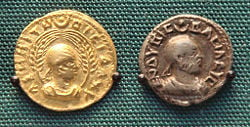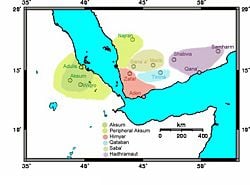Aksumite Empire

The Aksumite Empire or Axumite Empire (sometimes called the Kingdom of Aksum or Axum), was an important trading nation in northeastern Africa, growing from the proto-Aksumite period ca. 4th century B.C.E. to achieve prominence by the 1st century CE. It is also the alleged resting place of the Ark of the Covenant and the home of the Queen of Sheba. Corresponding to present day Ethiopia, this was an ancient African civilization that traded widely throughout the ancient world. Converting to Christianity in the fourth century, the Ethiopian Orthodox Church continues to be the tradition of the majority of Ethiopians using its language (Ge'ez) and perpetuating aspects of the civilization's artistic tradition. [1] Ethiopian culture today has its roots in this civilization. The decline, from the seventh century, has been attributed both to climate change and to defeat at the hands of Judith, a legendary Jewish Queen. Cite error: Closing </ref> missing for <ref> tagThe 51 references in the Bible to "Ethiopia" refer to this civilization. In the eighteenth century, enslaved black preachers in the USA began to revive interest in the Aksumite empire, and in other ancient African civilizations, as a platform to instill pride and self-respect among their people. This gave momentum to what has been described as Ethiaopianism, which "revered" Ethiopia "as a symbol of black accomplishment and the 'promised land' for uprooted Africans". A whole industry has developed around this reverence for Ethiopia, "a multi-billion dollar industry, ranging from roots reggae music and Afrocentric book publishing to African heritage tourism, fashion and beauty products". [2]
History
Located in northern Ethiopia and Eritrea, Aksum was deeply involved in the trade network between India and the Mediterranean.
Aksum is mentioned in the 1st century CE Periplus of the Erythraean Sea as an important market place for ivory, which was exported throughout the ancient world:
"From that place to the city of the people called Auxumites there is a five days' journey more; to that place all the ivory is brought from the country beyond the Nile through the district called Cyeneum, and thence to Adulis....
Periplus of the Erythraean Sea, Para..4
According to the Periplus, the ruler of Aksum in the 1st century AD was Zoscales, who, besides ruling in Aksum also controlled two harbours on the Red Sea: Adulis (near Massawa) and Avalites (Assab). He is also said to have been familiar with Greek literature:
"These places, from the Calf-Eaters to the other Berber country, are governed by Zoscales; who is miserly in his ways and always striving for more, but otherwise upright, and acquainted with Greek literature."
Periplus of the Erythraean Sea, Para. 5 [3]
The Kingdom of Aksum benefited from a major transformation of the maritime trading system that linked the Roman Empire and India. This change took place around the start of the Common Era. The older trading system involved coastal sailing and many intermediary ports. The Red Sea was of secondary importance to the Persian Gulf and overland connections to the Levant. Starting around 100 B.C.E. a route from Egypt to India was established, making use of the Red Sea and using monsoon winds to cross the Arabian Sea directly to southern India. By about 100 C.E. the volume of traffic being shipped on this route had eclipsed older routes. Roman demand for goods from southern India increased dramatically, resulting in greater number of large ships sailing down the Red Sea from Roman Egypt to the Arabian Sea and India.
The Kingdom of Aksum was ideally located to take advantage of the new trading situation. Adulis soon became the main port for the export of African goods, such as ivory, incense, gold, and exotic animals. In order to supply such goods the kings of Aksum worked to develop and expand an inland trading network. A rival, and much older trading network that tapped the same interior region of Africa was that of the Kingdom of Kush, which had long supplied Egypt with African goods via the Nile corridor. By the 1st century AD, however, Aksum had gained control over territory previously Kushite. The Periplus of the Erythraean Sea explicitly describes how ivory collected in Kushite territory was being exported through the port of Adulis instead of being taken to Meroë, the capital of Kush. During the 2nd and 3rd centuries the Kingdom of Aksum continued to expand their control of the southern Red Sea basin. A caravan route to Egypt was established which bypassed the Nile corridor entirely. Aksum succeeded in becoming the principal supplier of African goods to the Roman Empire, not least as a result of the transformed Indian Ocean trading system.[4]
In the 3rd century, Aksum began interfering in South Arabian affairs, controlling at times the western Tihama region among other areas. By the late 3rd century it had begun minting its own currency and was named by Mani as one of the four great powers of his time along with Persia, Rome, and China. It converted to Christianity in 325 or 328 under King Ezana and was the first state ever to use the image of the cross on its coins. At its height, Aksum controlled northern Ethiopia, Eritrea, northern Sudan, southern Egypt, Djibouti, Yemen, and southern Saudi Arabia, totalling 1.25 million km².[5]
It was a quasi-ally of Byzantium against the Persian Empire of the day and declined after the 7th century due to unknown reasons, but informed speculation suggests the rise of Islam heavily impacted its ability to trade with the Far East in the era when shipping was limited to coastal navigation as well as cut it off from its principal markets in Alexandria, Byzantium and Southern Europe.
After a second golden age in the early 6th century, the empire began to decline, eventually ceasing its production of coins in the early 7th century. It finally dissolved with the invasion of the pagan or Jewish queen Gudit in the 9th or 10th century, resulting in a Dark Age about which little is known until the rise of the Zagwe dynasty.
Origins
Aksum was previously thought to have been founded by Semitic-speaking Sabaeans who crossed the Red Sea from South Arabia (modern Yemen) on the basis of Conti Rossini's theories and prolific work on Ethiopian history, but most scholars now agree that it was an indigenous development.[6] Scholars like Stuart Munro-Hay point to the existence of an older D’mt or Da'amot kingdom, prior to any Sabaean migration ca. 4th or 5th c. BC, as well as to evidence of Sabaean immigrants having resided in the region for little more than a few decades.[7] Furthermore, Ge'ez, the ancient Semitic language of Eritrea and Ethiopia, is now known not to have derived from Sabaean, and there is evidence of a Semitic speaking presence in Ethiopia and Eritrea at least as early as 2000 B.C.E.[8][9] Sabaean influence is now thought to have been minor, limited to a few localities, and disappearing after a few decades or a century, perhaps representing a trading or military colony in some sort of symbiosis or military alliance with the civilization of D`mt or some proto-Aksumite state.[10] Adding more to the confusion, there existed an Ethiopian city called Saba in the ancient period that does not seem to have been a Sabaean settlement.
The Empire
The Empire of Aksum at its height extended across portions of presen
- ↑ "Foundations of Aksumite Civilization and Its Christian Legacy," Timeline of Art History, NY: Metropolitan Museum Foundations of Aksumite Civilization and Its Christian Legacy Retrieved May 14, 2008.
- ↑ Chamley, Santorri. 2008. New African, Feb. "Rise and rise of black consciousness." Rise and Rise of Black Consciousness Retrieved May 14, 2008.
- ↑ from W.H. Schoff (tr. & ed.), The Periplus of the Erythraean Sea: Travel and Trade in the Indian Ocean by a Merchant of the First Century (London, Bombay & Calcutta 1912) at Ancient History Sourcebook, Fordham University Source Retrieved May 14, 2008.
- ↑ The effect of the Indian Ocean trading system on the rise of Aksum is described in Burnstein, Stanley M. 2001, “State Formation in Ancient Northeast Africa and the Indian Ocean Trade,” University of California at Los Angeles, State Formation in Ancient Northeast Africa and the Indian Ocean Trade Retrieved May 14, 2008.
- ↑ Turchin, Peter, Adams, Jonathan M and Hall, Thomas D. 2004. “East West Orientation of Historical Empires,” University of Connecticut East-West Orientation of Historical Empires Retrieved May 14, 2008.
- ↑ Stuart Munro-Hay, p.57.
- ↑ Munro-Hay, p. 57.
- ↑ ibid.
- ↑ Herausgegeben von Uhlig, Siegbert (Ed). 2005.. Encyclopaedia Aethiopica, "Ge'ez." Wiesbaden: Harrassowitz Verlag, ISBN 9783447047463, p. 732.
- ↑ Munro-Hay, Aksum, p.57.

